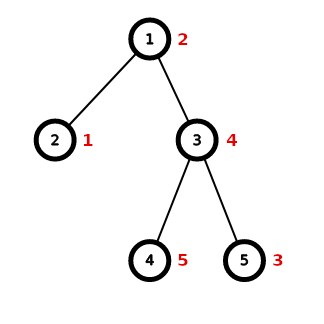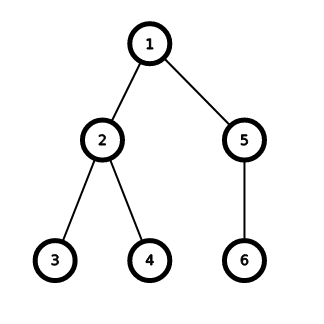310592: CF1856E1. PermuTree (easy version)
Description
This is the easy version of the problem. The differences between the two versions are the constraint on $n$ and the time limit. You can make hacks only if both versions of the problem are solved.
You are given a tree with $n$ vertices rooted at vertex $1$.
For some permutation$^\dagger$ $a$ of length $n$, let $f(a)$ be the number of pairs of vertices $(u, v)$ such that $a_u < a_{\operatorname{lca}(u, v)} < a_v$. Here, $\operatorname{lca}(u,v)$ denotes the lowest common ancestor of vertices $u$ and $v$.
Find the maximum possible value of $f(a)$ over all permutations $a$ of length $n$.
$^\dagger$ A permutation of length $n$ is an array consisting of $n$ distinct integers from $1$ to $n$ in arbitrary order. For example, $[2,3,1,5,4]$ is a permutation, but $[1,2,2]$ is not a permutation ($2$ appears twice in the array), and $[1,3,4]$ is also not a permutation ($n=3$ but there is $4$ in the array).
InputThe first line contains a single integer $n$ ($2 \le n \le 5000$).
The second line contains $n - 1$ integers $p_2,p_3,\ldots,p_n$ ($1 \le p_i < i$) indicating that there is an edge between vertices $i$ and $p_i$.
OutputOutput the maximum value of $f(a)$.
ExamplesInput5 1 1 3 3Output
4Input
2 1Output
0Input
6 1 2 2 1 5Output
7Input
4 1 1 1Output
2Note
The tree in the first test:

One possible optimal permutation $a$ is $[2, 1, 4, 5, 3]$ with $4$ suitable pairs of vertices:
- $(2, 3)$, since $\operatorname{lca}(2, 3) = 1$ and $1 < 2 < 4$,
- $(2, 4)$, since $\operatorname{lca}(2, 4) = 1$ and $1 < 2 < 5$,
- $(2, 5)$, since $\operatorname{lca}(2, 5) = 1$ and $1 < 2 < 3$,
- $(5, 4)$, since $\operatorname{lca}(5, 4) = 3$ and $3 < 4 < 5$.
The tree in the third test:

The tree in the fourth test:

Output
这是一个关于树的问题的简单版本。两个版本的区别在于对n的限制和时限。只有当问题的两个版本都解决时,你才能进行黑客攻击。
给你一个有n个顶点的树,根顶点为1。
对于长度为n的某个排列a,定义f(a)为满足a_u < a_{lca(u, v)} < a_v的顶点对(u, v)的数量。这里,lca(u,v)表示顶点u和v的最低共同祖先。
求所有长度为n的排列a中f(a)的最大可能值。
输入输出数据格式:
输入:
第一行包含一个整数n(2≤n≤5000)。
第二行包含n-1个整数p_2, p_3, …, p_n(1≤p_i < i),表示顶点i和p_i之间有一条边。
输出:
输出f(a)的最大值。
示例:
输入:
5
1 1 3 3
输出:
4
输入:
2
1
输出:
0
输入:
6
1 2 2 1 5
输出:
7
输入:
4
1 1 1
输出:
2题目大意: 这是一个关于树的问题的简单版本。两个版本的区别在于对n的限制和时限。只有当问题的两个版本都解决时,你才能进行黑客攻击。 给你一个有n个顶点的树,根顶点为1。 对于长度为n的某个排列a,定义f(a)为满足a_u < a_{lca(u, v)} < a_v的顶点对(u, v)的数量。这里,lca(u,v)表示顶点u和v的最低共同祖先。 求所有长度为n的排列a中f(a)的最大可能值。 输入输出数据格式: 输入: 第一行包含一个整数n(2≤n≤5000)。 第二行包含n-1个整数p_2, p_3, …, p_n(1≤p_i < i),表示顶点i和p_i之间有一条边。 输出: 输出f(a)的最大值。 示例: 输入: 5 1 1 3 3 输出: 4 输入: 2 1 输出: 0 输入: 6 1 2 2 1 5 输出: 7 输入: 4 1 1 1 输出: 2